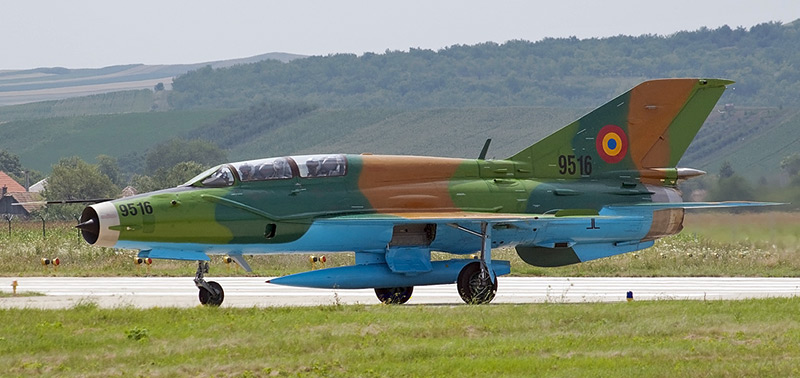By Jean-Michel Guhl

23 August 2015, Bacău Romania — Twenty years ago today – 23 August 1995 – the first prototype MiG-21MF-75 Lancer took to the air from Aerostar’s Bacău facility in north-east Romania. Developed as a joint endeavor between the Forţele Aeriene Române (Romanian Air Force), the local Aerostar company and Elbit Systems of Israel, the MiG-21 Lancer is still considered as the most complete and advanced fighter jet upgrade program ever undertaken in Eastern Europe, even if only less than forty Lancer B and C models still soldier on today, operating from three air bases — 71 Flotila in Câmpia Turzil, 86 Flotila in Borcea and 95 Flotila in Bacău.
A total of 110 aircraft were upgraded in three different variants (Lancer A – air-to-ground close support; Lancer B – air-to-ground two seater; and Lancer C – air-to-air superiority) and in all these roles the aircraft has achieved total compatibility with the navigation and armament systems operational in aircraft used in Western countries. Of all the fighter aircraft impressed in active service by the Forţele Aeriene Române since the 1970s, the legacy and upgraded MiG-21MF and MiG-21UM fighters is an interesting machine since it has survived in field service both the more modern Soviet MiG-23 ‘Flogger’ and MiG-29 ‘Fulcrum’ (retired in 2003). The aircraft is particularly appreciated for its ruggedness and well beloved by the Romanian pilots, particularly since its Israeli-made avionics suite and radar are very user-friendly in comparison with the antiquated Soviet systems of the legacy MiG-21MF.
The Lancers are scheduled to be replaced next year by 12 second-hand Lockheed Martin F-16 Fighting Falcons purchased from Portugal , to make the FAR even more integrated within NATO. The first aircraft delivery is planned for 2016, to enable the FAR to achieve initial operational capability (IOC) in 2017, with the assistance and support of both Portuguese Air Force (FAP) and US Air Force personnel.

The success of this cost-effective program owes much to the Romanian Air Force’s initial definition of requirements and concept for the aircraft’s modernization and, equally, the upgrade execution by both Aerostar and Elbit. Today the MiG-21 Lancer still is in front-line service with the Romanian Air Force and remains completely functional and compatible with present generation fighter aircraft. “By defining the specifications and the design and implementation concept in a partnership of Aerostar with the Romanian Air Force Staff and the Israeli Elbit Systems Company, this program is the broadest and most advanced upgrade of an aircarft made in Eastern Europe, through which the navigation and weaponry systems became compatible with those at Western countries’ level,” Aerostar Chairman & CEO Grigore Filip revealed.
The 20 years of continued service of the upgraded aircraft, including participation in international missions, is proof that the success of the programme is based on good and visionary decisions taken more than two decades ago. The two-decade history since the first flight of the Romanian version of the ‘Fishbed’ (NATO code name for Soviet Mikoyan i Gurevich MiG-21) is also completed by the 95 Air Base in Bacău, the training centre for over 500 young pilots, including the first two Romanian females licensed in flying supersonic military aircraft.
Aerostar, whilst marking this 20-year anniversary of the MiG-21 Lancer first flight notes, that, in addition to the modernization program itself — very much supported by Israel —, its post-delivery support for the upgraded aircraft has successfully underlined its role as a supplier of advanced solutions and maintenance for the Romanian Air Force.
Going into details, from 1996 the Romanian air force received 71 Lancer A ground attack variants with Elta EL/M-2001B radar, 14 Lancer B two-seat conversion trainers (based on the MiG-21UM) and 26 Lancer C air defense fighters with EL/M-2032 radar with Rafael Python 3 missile capability.

